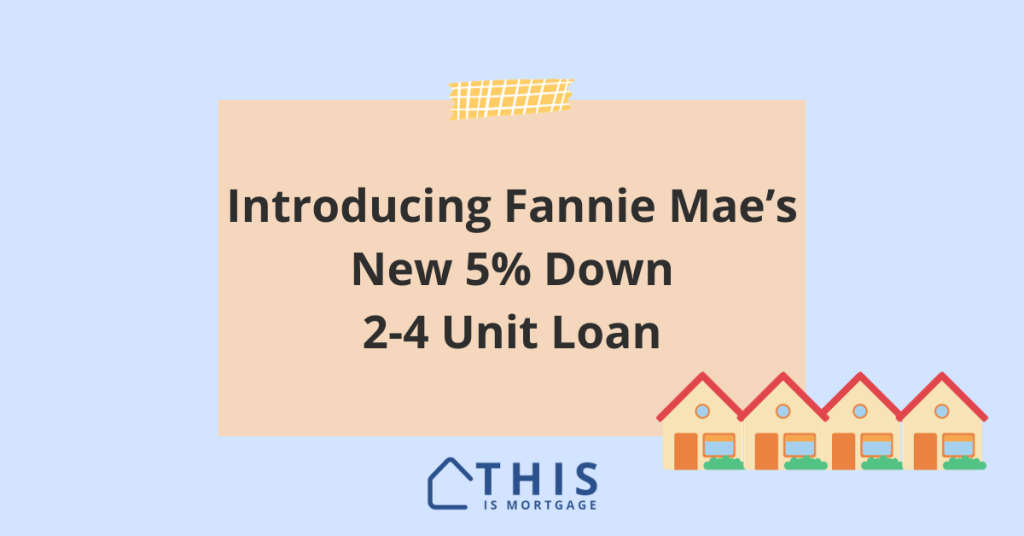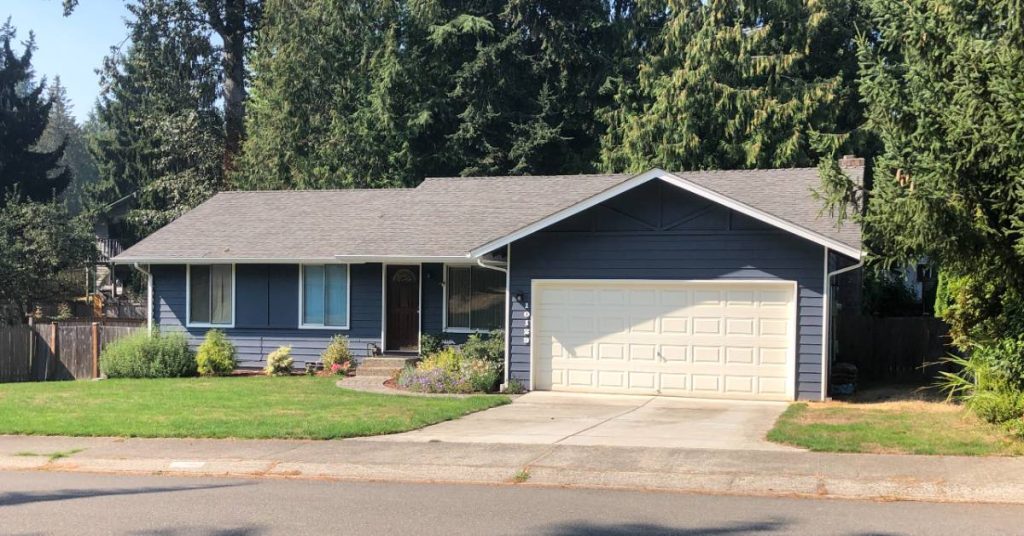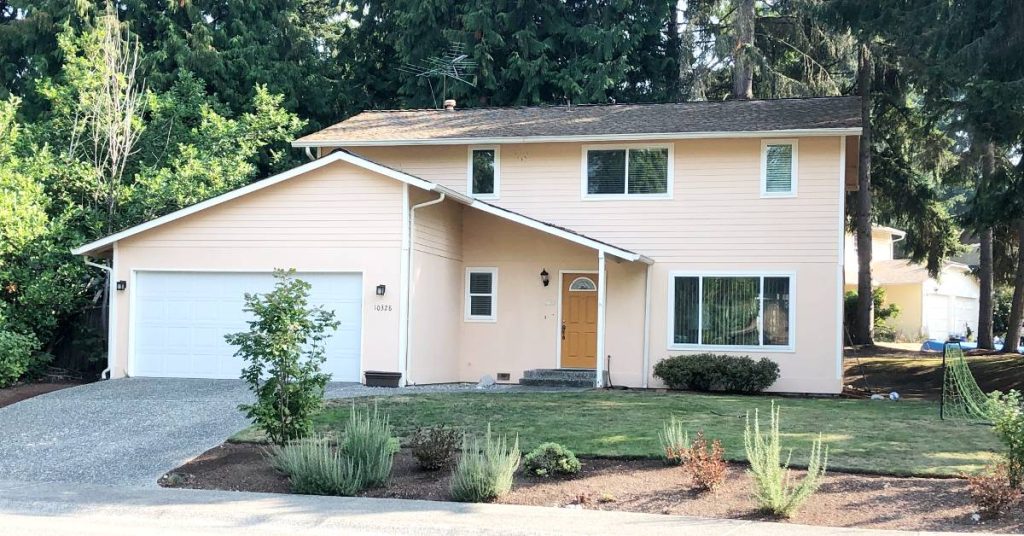It’s official: Fannie Mae now allows 5% down payments for owner-occupied 2-, 3-, and 4-unit (multifamily) homes.
This is a surprising reversal of the years-long policy of requiring 15-25% down for duplexes, triplexes, and four-plexes. It will be a major benefit to those looking to purchase a multifamily home to live in.
Anyone in the market to live in a home while collecting rent and building landlord experience should take action to secure this new option as soon as it becomes available.
Connect with a lender to start on the new 5% down 2-4 unit loan.
Fannie Mae to repeal 15%-25% down payment requirement
Fannie Mae announced on October 4, 2023 that it will drastically reduce multifamily home down payment requirements for owner-occupied transactions (where the buyer will live in one of the units).
| Standard, Homeready, and HomeStyle Reno Owner-Occupied | Units | Former LTV | New LTV |
| Purchase/No-Cash Refi, Fixed/ARM | 2 | 85% | 95% |
| Purchase/No-Cash Refi, Fixed/ARM | 3-4 | 75% | 95% |
@this_is_mortgage Huge news for homebuyers. 5% down duplex, triplex, 4-plex conventional loan Not FHA. #househacking #multifamilyinvesting #fanniemae #homebuyertips #thisismortgage #firsttimehomebuyer
♬ Standout – Kid Dean
It could mean big changes for multifamily home buyers.
Fannie Mae is known for offering down payments as little as 3-5%. Before the change, that only applied to 1-unit properties.
A two-unit home (duplex) required 15% down and 3-4 unit homes required 25% down. Both will be reduced to 5%.
That previous down payment levels hindered many would-be owner-landlords. Especially since these properties are much more expensive than a typical single-family home.
A $500,000 triplex required a $125,000 down payment. But effective November 18, 2023, only 5% down will be required, or $25,000, a difference of $100,000 in this case.
Following are additional examples of reduced down payment needed.
| 2-Unit | 3-4 Unit | |
| Example home price | $400,000 | $500,000 |
| Min. down payment before 11/18/23 | $60,000 (15%) | $125,000 (25%) |
| Min. down payment after 11/18/23 | $20,000 (5%) | $25,000 (5%) |
| Upfront cash reduction | $40,000 | $100,000 |
The changes apply to standard purchases, no-cash-out refinances, HomeReady, and HomeStyle Renovation loans for owner-occupied transactions.
Connect with a lender to start your 5% down 2-4 unit loan.
Cash needed including reserves:
The down payment isn’t the only upfront cash needed. You will need:
- Down payment (5% of purchase price)
- Closing costs (around 2-4% of purchase price)
- Reserves (6 months of the full payment)
The big caveat to this new program is that Fannie Mae requires you to have six months of the full payment in reserve after paying the down payment and closing costs. You don’t need to pay this money, but you must prove you have it in an accessible account.
For example, a $400,000 duplex would require $20,000 down payment and about $12,000 in closing costs upfront and $21,000 in reserve after closing (assuming a $3,500 full payment). You would need $53,000 total in savings, checking, and other accounts to qualify.
This could be a large barrier for first-time buyers, but Fannie Mae has so far not repealed the six-month reserve rule.
What does this mean for multifamily homebuyers?
The benefits of the change can’t be overstated.
Currently, the only low-down-payment multifamily home loan (if you don’t have eligible military service) is the FHA loan. For just 3.5% down, buyers can own a 2, 3, or 4-unit home.
For duplexes, FHA works well. But FHA comes with a serious drawback for 3-4 unit properties: the self-sufficiency test. In this test, the property needs to be able to cover its entire payment with rental income after a vacancy factor of 25%. For example, a 4-unit home with a $5,000-per-month full payment would need market rents of nearly $6,700 per month.
With mortgage rates at decades-high levels, virtually no property can pass FHA’s test.
Now that Fannie Mae has rolled out a 5% down conventional option with no self-sufficiency requirement, many buyers could finally get pre-approved for a 3-4 unit property.
First-time buyers, house hackers, and those who just want to offset high mortgage payments could finally get a chance at homeownership and real estate investing.
Can first-time buyers use rental income to qualify?
In most cases, even first-time buyers can use rental income from the 2-4 unit property to help them qualify. However, you must have a current housing expense (must be paying rent).
Those living rent-free can’t use future rental income to qualify for the loan.
Current renters who have no history of landlord experience can use future rental income to qualify, up to the amount of the full house payment.
| Example: Using future rental income to qualify | |
| Employment income | $7,000 per month |
| Future rental income from units you won’t live in less 25% vacancy factor | $3,000 |
| Full payment incl. taxes, insurance, etc. | $3,500 |
| Total qualifying income | $10,000 |
Because the borrower’s future rental income is less than the payment, she can add it to her employment income, less a 25% vacancy factor.
Future rental income, then, can go a long way toward helping you qualify for high home prices and mortgage rates that we’re seeing in the market today.
Connect with a loan professional to start on your multifamily home loan.
Why is Fannie Mae doing this?
According to the announcement, the agency wants to support:
- Access to credit
- Affordable rental housing.
With rents and mortgage rates rising, many buyers are looking for creative and alternative ways to afford a home. This includes using rental income to offset the payment. This guideline update could help home buyers reduce their monthly cost of ownership.
Many have resorted to renting out a room to accomplish this goal. Now they might be able to purchase an actual multifamily property instead.
Additionally, Fannie Mae says this move will encourage affordable rental housing. It’s unclear how an owner-occupied 2-4 unit home would provide more rental housing than it already is. Still, this is welcome news for anyone who wants to collect rent on their primary residence.
Maximum loan amount $1,396,800 (no high-balance)
The announcement states that the change only applies to standard conforming loan amounts, not increased loan amounts in high-cost areas, known as high-balance loans.
Still, this gives buyers plenty of room to purchase an expensive property, thanks to increased limits for 2-4 unit properties.
| Units | Maximum Loan 2023 |
| 2-unit | $929,850 |
| 3-unit | $1,123,900 |
| 4-unit | $1,396,800 |
Assuming 5% down, purchase prices could be:
- $978,785 maximum price for 2 units
- $1,183,050 maximum price for 3 units
- $1,470,315 maximum price for 4 units
Buyers making larger down payments could purchase even more expensive properties.
Again, with no FHA self-sufficiency test, buyers have a whole new world opened up for them.
When can homebuyers apply?
Updated: November 20, 2023:
Interested homebuyers can apply now. The program is active.
Fannie Mae’s automated underwriting system is now updated and lenders are accepting applications and issue pre-approvals for qualified applicants.
Request your 5% down multifamily pre-approval from a lender.
Seismic change for owner-occupant landlords
Homebuyers who want to get their feet wet as a landlord or just reduce mortgage payments with rental income just got a huge gift from Fannie Mae.
Interested homebuyers should apply now to determine if they might qualify. If they can find enough funds for a 5% down payment, closing costs, and reserves, they could soon be the owner of a 2-4 unit property.




